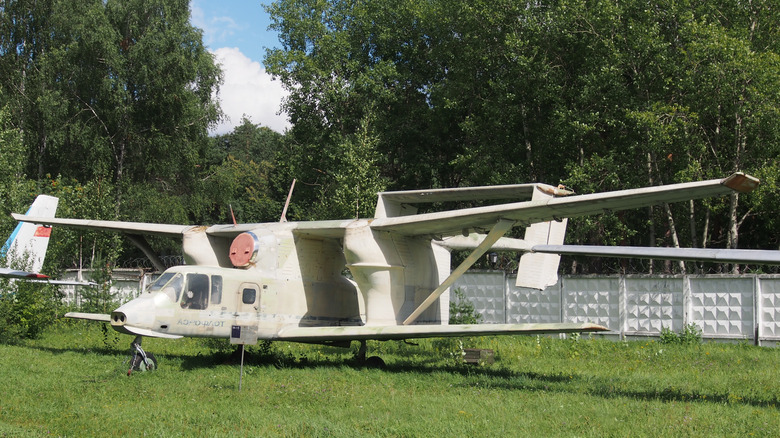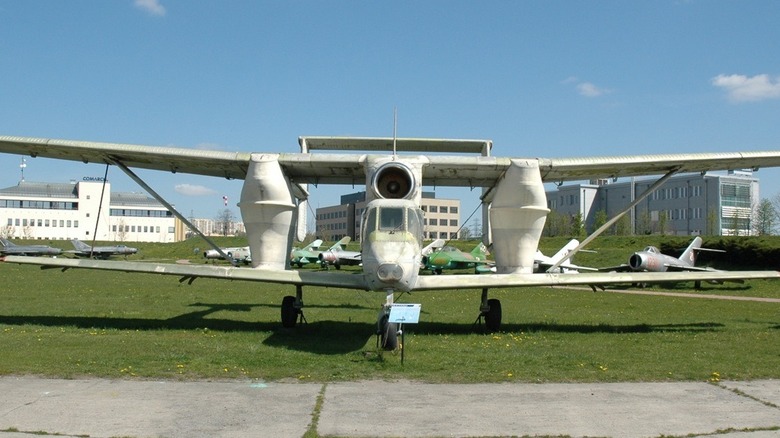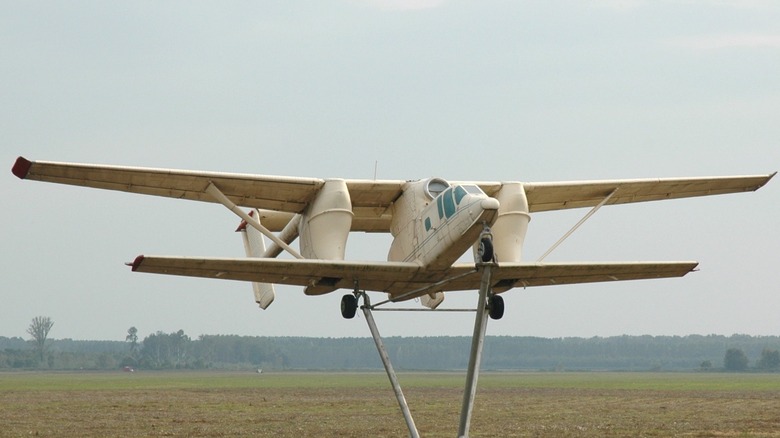This Plane Set The Record For The Slowest Jet To Ever Fly
Ever since Sir Frank Whittle in England and Hans von Ohain in Germany worked separately to invent the jet engine, the engine has been associated with high-performance machines. And, of course, some of the world's most iconic planes have been powered by the jet engine. Legends like the trail-blazing shark-like appearance of the Messerschmitt Me 262 and the unmistakable profile of the SR-71 Blackbird are just two examples. And then there's the Polish-built PZL M-15 Belphegor. The PZL M-15 is proof that not all jet planes have to look the part — or streak through the air, for that matter.
Despite hailing from the 1970s, you'd be forgiven for thinking that the PZL M-15 was based on the blueprints for a WW1 biplane, a design that some engineer had decided to strap a jet engine to. To date, it's the only jet-powered biplane to have been produced. And with a top speed of just 120 mph, it also holds the dubious record of being the slowest jet ever built. However, it was built for a purpose that didn't require speed. More specifically, it was designed as a crop duster, hence the rather agricultural performance. It's also fair to say that its appearance at the Paris International Air Show in 1976 didn't enhance its reputation. With press reports suggesting that the plane "does not need chemicals, as soon as it flies over the fields, all the pests will die of laughter."
Why was the PZL M-15 so slow?
To be fair to the engineers who developed the PZL M-15, it was designed for a purpose, and many of its attributes are there to fit this purpose. Let's begin with the decision to furnish the plane with two sets of wings. The biplane configuration makes sense when you consider the job the plane was intended for. The plane was built to perform crop dusting duties, spread fertilizer, and could even be used for fire suppression. None of these tasks require high-speed, highly maneuverable characteristics. Rather, they require high stability at lower speeds. This is what a biplane configuration provides. The downside of this is, of course, increased weight and drag. A problem that is exacerbated by the massive wing support struts that doubled as chemical tanks.
The unusual tail design of the plane was also a compromise. In this case, it was designed to ensure that exhaust gases from the jet engine didn't mix with the dispersed chemicals; this also explains why the engine was mounted on top of the fuselage. The engine itself was an Ivchenko-Progress AI-25 turbojet, which could produce 3,300 pounds of thrust. With a maximum take-off weight of 12,456 pounds, this gave the Belphegor a rather pedestrian thrust-to-weight ratio of 0.26. For comparison, the blindingly fast F-22 Raptor has a thrust-to-weight ratio of 1.25. Hardly a fair comparison, but these figures do help to demonstrate just why this jet was so slow.
The PZL M-15 was slow, but was it bad?
If slow speed and dreadful looks were metrics that we measure the success of a plane on, then the poor old Belphegor would certainly be on the top step of the podium. However, by these standards, the legendary A-10 Thunderbolt would be joining it on the podium. The Thunderbolt is hardly the prettiest piece of engineering and is certainly no speed merchant with a comfortable cruising speed of 420 mph, yet it's a successful plane. Unfortunately, for the PZL M-15, success was rather more limited. The Belphegor was designed to replace another aviation legend — the Soviet Antonov An-2 biplane, an aging piston-engined design that had been in production since 1947, a production run that would continue until 2002, by which point nearly 12,000 had been built. By contrast, the M-15 had less lofty aspirations, with a production run of 3,000 being envisaged. In the end, a mere 175 aircraft were built before production stopped in 1981.
It wasn't a performance issue; pilots loved its simplicity, maneuverability, and comfort. However, when compared to the An-2, the plane was expensive to run and maintain, and aircrew had to go through retraining before being able to fly. The aerodynamic drag that helped the plane perform at low speeds also had a huge influence on the efficiency of the engine. The M-15 used more than three times the fuel of the Antonov An-2 per hour of flight. Ultimately, this was what consigned the Belphegor to the fate of an ambitious, but ugly, failure.


